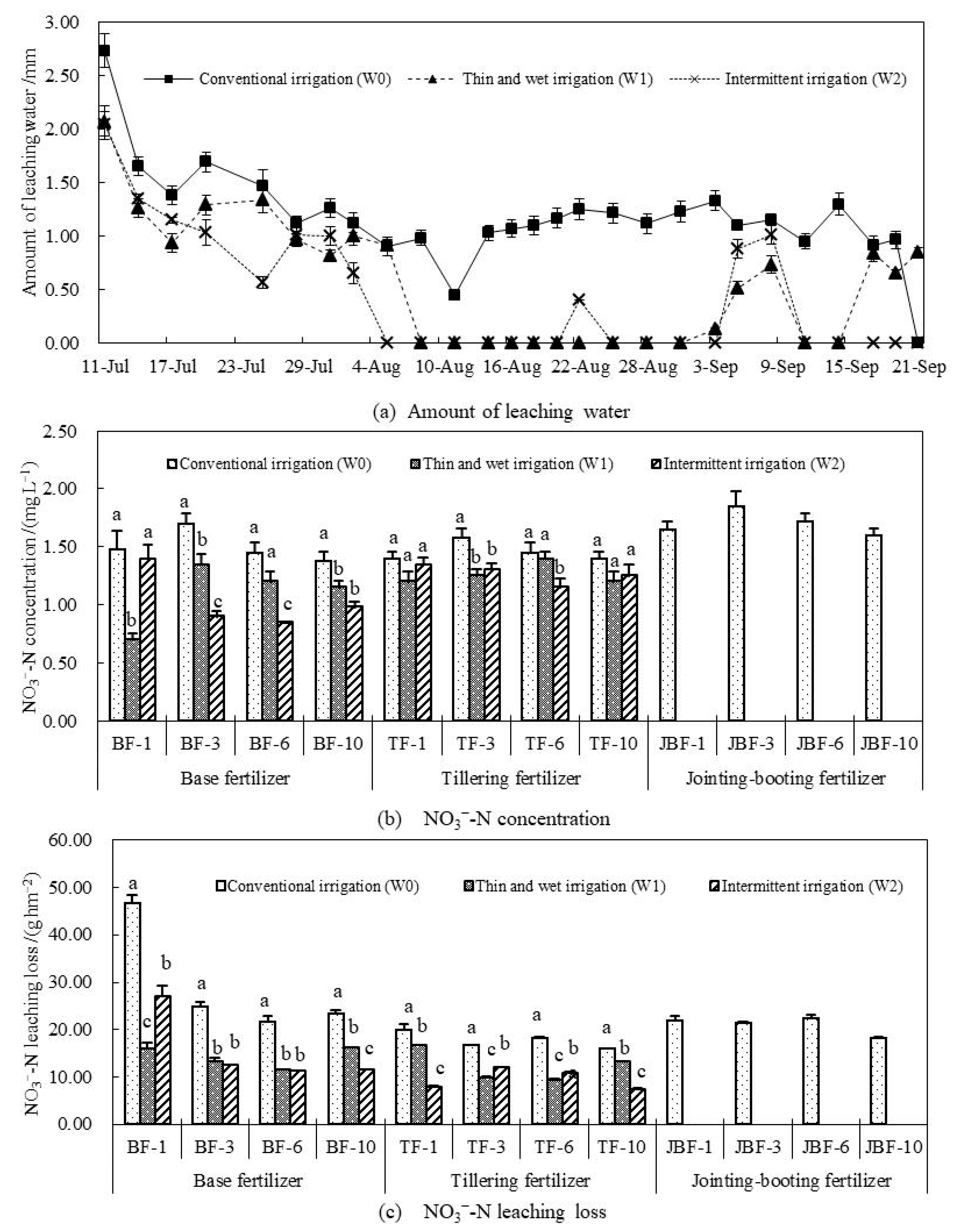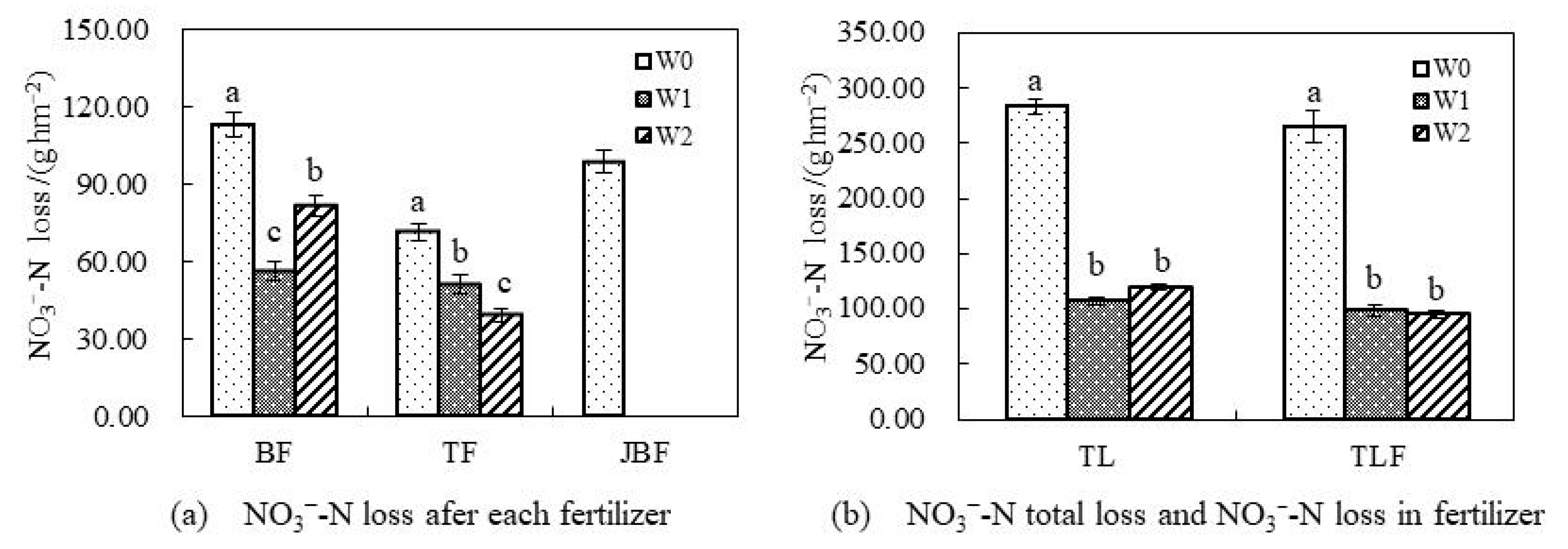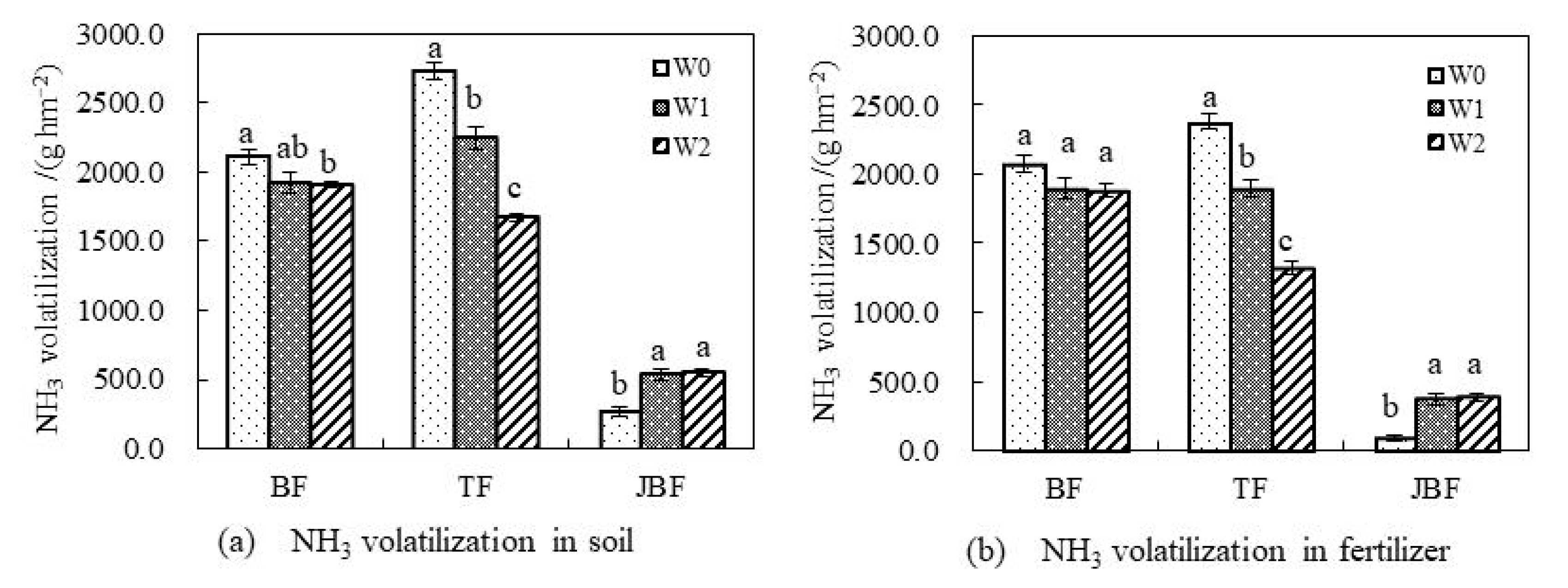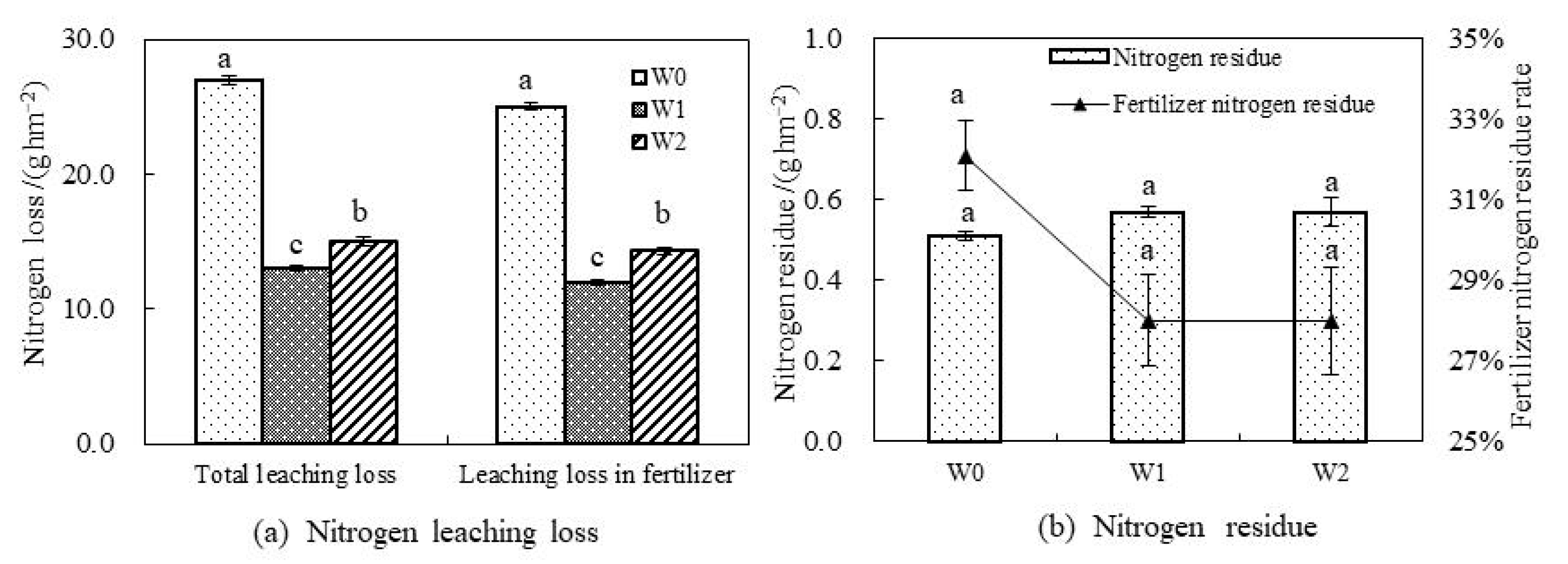Study on the Law of Nitrogen Transfer and Conversion and Use of Fertilizer Nitrogen in Paddy Fields under Water-Saving Irrigation Mode
Abstract
:1. Introduction
2. Methods
2.1. Experimental Site
2.2. Experimental Design
2.3. Method
3. Results and Discussion
3.1. Effects of Nitrogen Leaching Loss in Paddy Field under Different Irrigation Modes
3.2. Effects of Total Nitrogen Leaching Loss in Paddy Field under Different Irrigation Modes
3.3. Effects of NH3 Volatilization Loss in Paddy Field under Different Irrigation Modes
3.4. Differences between Soil Nitrogen Absorption and Fertilizer Nitrogen Absorption by Rice Plant under Different Irrigation Modes
3.5. Differences between Leaching Amounts of Soil Nitrogen and Fertilizer Nitrogen under Different Irrigation Modes
3.6. Nitrogen Transfer and Conversion of Fertilizers under Different Irrigation Modes
4. Conclusions
- Water-saving irrigation mode reduced the amount of NO3−-N leaching loss by reducing leakage and NO3−-N concentration. There is no significant difference between the leakage amount and NO3−-N concentration in W1 and W2. In addition, the inhibition effect on fertilizer nitrogen leaching was W1 ≈ W2 > W0. The fertilizer nitrogen leaching loss in W1 and W2 decreased by 62% and 64% compared with W0, respectively.
- Under the same amount of fertilizer, the total amount of NH3 volatilization in “water-saving irrigation + three times of fertilization” mode was significantly less than that in conventional irrigation, and the proportion of NH3 volatilization of fertilizer in total NH3 volatilization was reduced. The contribution rate of NH3 volatilization in W0 was 34.12% at jointing-booting stage, and the same in W1 and W2 was 69.41% and 70.12%, respectively.
- Nitrogen uptake of rice plant in different irrigation modes showed a trend of W1 > W2 > W0. With the development of growth stage, the ratio of fertilizer nitrogen uptake to total nitrogen uptake of rice plant showed a downward trend. The amount of fertilizer nitrogen uptake of rice plant in W0, W1, and W2 ranged from 51.0% to 58.0%, 40.0% to 69.7%, and 50.5% to 58.7%, respectively.
- Compared with the original soil, the total nitrogen content of paddy field under water-saving irrigation increased by 14.0%. The total nitrogen content of paddy field under conventional irrigation basically remained unchanged. At the same time, the residue rates of fertilizer nitrogen in W1 and W2 were less than those in the W0, with a decrease of 14.6%. The uptake rate of fertilizer nitrogen in W0, W1, and W2 was 33.1%, 42.3%, and 47.3%, respectively.
- Leaching loss, soil residue, and NH3 volatilization of fertilizer nitrogen in water-saving irrigation mode (W1, W2) were all less than that in conventional irrigation mode (W0), while the corresponding nitrogen uptake by crops was significantly higher than that in W0. Nitrogen use efficiency of W1 and W2 increased by 5.0% and 9.7%, respectively, compared with W0, indicating that the two water-saving irrigation modes improved nitrogen uptake by paddy rice, and reduced environmental pollution caused by fertilizer.
Author Contributions
Funding
Acknowledgments
Conflicts of Interest
References
- Jobin, C.; Duquette, P. The impact of agricultural extension on farmer nutrient management behavior in chinese rice production: A household-level analysis. Sustainability 2014, 6, 6644–6665. [Google Scholar]
- Zhang, W.; Li, T.; Huang, Y.; Zhang, Q.; Bian, J.; Han, P. Estimation of uncertainties due to data scarcity in model upscaling: A case study of methane emissions from rice paddies in china. Geosci. Model Dev. Discuss. 2014, 7, 181–216. [Google Scholar] [CrossRef]
- Dasgupta, P.; Das, B.S.; Sen, S.K. Soil water potential and recoverable water stress in drought tolerant and susceptible rice varieties. Agric. Water Manag. 2015, 152, 110–118. [Google Scholar] [CrossRef]
- Xu, J.Z.; Peng, S.Z.; Yang, S.H.; Wang, W.G. Ammonia volatilization losses from a rice paddy with different irrigation and nitrogen managements. Agric. Water Manag. 2012, 104, 184–192. [Google Scholar] [CrossRef]
- Tan, X.; Shao, D.; Liu, H.; Yang, F.; Xiao, C.; Yang, H. Effects of alternate wetting and drying irrigation on percolation and nitrogen leaching in paddy fields. Paddy Water Environ. 2013, 11, 381–395. [Google Scholar] [CrossRef]
- Zhang, D.; Jiao, X.; Du, Q.; Song, X.; Li, J. Reducing the excessive evaporative demand improved photosynthesis capacity at low costs of irrigation via regulating water driving force and moderating plant water stress of two tomato cultivars. Agric. Water Manag. 2018, 199, 22–33. [Google Scholar] [CrossRef]
- Subramanian, K.S.; Selvakumari, G.; Selvaraj, K.V.; Chinnaswami, K.N. Irrigation regimes on utilization of nutrients, yield and quality of sugarcane (Saccharum officinarum L.). J. Agron. Crop Sci. 2010, 167, 155–158. [Google Scholar] [CrossRef]
- Liang, Y.; Li, F.; Nong, M.; Hui, L.; Zhang, J. Microbial activity in paddy soil and water-use efficiency of rice as affected by irrigation method and nitrogen level. Commun. Soil Sci. Plant Anal. 2016, 47, 19–31. [Google Scholar] [CrossRef]
- Lin, L.; Zhang, Z.; Janssen, M.; Lennartz, B. Infiltration properties of paddy fields under intermittent irrigation. Paddy Water Environ. 2014, 12, 17–24. [Google Scholar] [CrossRef]
- Bhantana, P.; Lazarovitch, N. Evapotranspiration, crop coefficient and growth of two young pomegranate (Punica granatum L.) varieties under salt stress. Agric. Water Manag. 2010, 97, 715–722. [Google Scholar] [CrossRef]
- Mao, Z. Water Saving Irrigation for Rice and Its Effect on Environment. Eng. Sci. 2002, 4, 8–16. [Google Scholar]
- Yang, Y.; Cui, Y.; Luo, Y.; Lyu, X.; Traore, S.; Khan, S. Short-term forecasting of daily reference evapotranspiration using the penman-monteith model and public weather forecasts. Agric. Water Manag. 2016, 177, 329–339. [Google Scholar] [CrossRef]
- Li, Q.; Hu, Y.; Sun, J.; Li, H. Loss characteristics of agricultural non-point source pollutants under controlled drainage. Trans. Chin. Soc. Agric. Eng. 2010, 26, 182–187. [Google Scholar]
- Wang, J.Y.; Jia, J.X.; Xiong, Z.Q.; Khalil, M.A.K.; Xing, G.X. Water regime–nitrogen fertilizer–straw incorporation interaction: Field study on nitrous oxide emissions from a rice agroecosystem in Nanjing, China. Agric. Ecosyst. Environ. 2011, 141, 437–446. [Google Scholar] [CrossRef]
- Kreye, C.; Dittert, K.; Zheng, X.; Zhang, X.; Lin, S.; Tao, H. Fluxes of methane and nitrous oxide in water-saving rice production in north china. Nutr. Cycl. Agroecosyst. 2007, 77, 293–304. [Google Scholar] [CrossRef]
- Okubo, T.; Sato, Y.; Azuma, Y. Movements of nitrogen and phosphorus in paddy fields utilizing irrigation water with high nutrient concentrations. J. Jpn. Soc. Water Environ. 2014, 37, 177–187. [Google Scholar] [CrossRef]
- Zhu, H.; Chen, X.; Zhang, Y. Temporal and spatial variability of nitrogen in rice–wheat rotation in field scale. Environ. Earth Sci. 2013, 68, 585–590. [Google Scholar] [CrossRef]
- Xiao, M.H.; Yu, S.E.; Wang, Y.Y.; Huang, R. Nitrogen and phosphorus changes and optimal drainage time of flooded paddy field based on environmental factors. Water Sci. Eng. 2013, 6, 164–177. [Google Scholar]
- Xiao, M.H.; Yu, S.E.; She, D.; Hu, X.J.; Chu, L.L. Nitrogen and phosphorus loss and optimal drainage time of paddy field under controlled drainage condition. Arab. J. Geosci. 2015, 8, 4411–4420. [Google Scholar] [CrossRef]
- Xiao, M.H.; Miao, Z.M.; Li, Y.Y. Changes of root-zone soil environment in flooded paddy field under controlled drainage conditions. Pol. J. Environ. Stud. 2017, 2, 881–892. [Google Scholar] [CrossRef]
- Ouyang, W.; Xu, Y.; Hao, F.; Wang, X.; Siyang, C.; Lin, C. Effect of long-term agricultural cultivation and land use conversion on soil nutrient contents in the sanjiang plain. CATENA 2013, 104, 243–250. [Google Scholar] [CrossRef]
- Xu, S.; Zhang, B.; Ma, L.; Hou, A.; Tian, L.; Li, X. Effects of marsh cultivation and restoration on soil microbial communities in the sanjiang plain, northeastern china. Eur. J. Soil Biol. 2017, 82, 81–87. [Google Scholar] [CrossRef]
- Kallenbach, C.M.; Rolston, D.E.; Horwath, W.R. Cover cropping affects soil N2O and CO2 emissions differently depending on type of irrigation. Agric. Ecosyst. Environ. 2010, 137, 251–260. [Google Scholar] [CrossRef]
- Riya, S.; Zhou, S.; Kobara, Y.; Sagehashi, M.; Terada, A.; Hosomi, M. Influence of nitrogen loading and plant nitrogen assimilation on nitrogen leaching and N2O emission in forage rice paddy fields fertilized with liquid cattle waste. Environ. Sci. Pollut. Res. 2015, 22, 5762–5771. [Google Scholar] [CrossRef] [PubMed]
- Hay, F.J.; Vietor, D.M.; Munster, C.L.; White, R.H.; Provin, T.L. Leaching loss of no3-n and dissolved p from manure and fertilizer during turfgrass establishment. Plant Soil 2017, 296, 1–17. [Google Scholar] [CrossRef]
- Parfitt, R.L.; Mackay, A.D.; Ross, D.J.; Budding, P.J. Effects of soil fertility on leaching losses of n, p and c in hill country. New Zealand J. Agric. Res. 2009, 52, 495–497. [Google Scholar] [CrossRef]
- Zhang, M.; Tian, Y.; Zhao, M.; Yin, B.; Zhu, Z. The assessment of nitrate leaching in a rice–wheat rotation system using an improved agronomic practice aimed to increase rice crop yields. Agric. Ecosyst. Environ. 2017, 241, 100–109. [Google Scholar] [CrossRef]
- Zhao, X.; Yan, X.; Xie, Y.; Wang, S.; Xing, G.; Zhu, Z. Use of nitrogen isotope to determine fertilizer- and soil-derived ammonia volatilization in a rice/wheat rotation system. J. Agric. Food Chem. 2016, 64, 3017. [Google Scholar] [CrossRef]
- Qiao, J.; Yang, L.; Yan, T.; Xue, F.; Zhao, D. Nitrogen fertilizer reduction in rice production for two consecutive years in the taihu lake area. Agric. Ecosyst. Environ. 2012, 146, 103–112. [Google Scholar] [CrossRef]
- Hashim, M.; Yusop, M.K.; Othman, R.; Wahid, S.A. Characterization of nitrogen uptake pattern in malaysian rice mr219 at different growth stages using 15N isotope. Rice Sci. 2015, 22, 250–254. [Google Scholar] [CrossRef]
- Jie, Z.; Wei, Z.; Wang, K.; Song, T.; Hu, D. Responses of the soil nematode community to management of hybrid napiergrass: The trade-off between positive and negative effects. Appl. Soil Ecol. 2014, 75, 134–144. [Google Scholar]
- Rahman, M.M.; Amano, T.; Shiraiwa, T. Nitrogen use efficiency and recovery from n fertilizer under rice-based cropping systems. Aust. J. Crop Sci. 2009, 3, 336–351. [Google Scholar]





| Irrigation Mode | Upper and Lower Limit | Return Green | Early Tilling | Late Pillaring | Jointing- Booting | Heading-Flowering | Milking | Yellow Maturity |
|---|---|---|---|---|---|---|---|---|
| W0 | Irrigation lower limit | 20 | 20 | 30 | 30 | 10 | 10 | 0 |
| Irrigation upper limit | 30 | 50 | 60 | 60 | 50 | 50 | 0 | |
| Rainfall storage upper limit | 50 | 70 | 90 | 100 | 100 | 60 | 20 | |
| W1 | Irrigation lower limit | 5 | 0.8 θs | 0.7 θs | 0.9 θs | 0 | 0.8 θs | Natural drying |
| Irrigation upper limit | 30 | 20 | 20 | 30 | 30 | 20 | ||
| Rainfall storage upper limit | 40 | 50 | 0 | 60 | 60 | 30 | ||
| W2 | Irrigation lower limit | 0 | Exposing field3–5 days | Exposing field 7–12 days | Exposing field 2–4 days | Exposing field2–4 days | Exposing field 3–5 days | Natural drying |
| Irrigation upper limit | 30 | 30 | Exposing field | 40 | 40 | 30 | ||
| Rainfall storage upper limit | 40 | 50 | Exposing field | 60 | 60 | 60 |
| Irrigation Mode | Grain | Plant | Total Amount | |||
|---|---|---|---|---|---|---|
| Total-N | Fertilizer-N | Total-N | Fertilizer-N | Total-N | Fertilizer-N | |
| W0 | 116 ± 3.46c ** | 60 ± 4.04bns | 51 ± 1.73c ** | 26 ± 0.58ans | 167 ± 4.04c ** | 86 ± 3.40bns |
| W1 | 171 ± 6.35a * | 70 ± 2.89bns | 70 ± 2.31a * | 28 ± 1.15ans | 241 ± 5.77a ** | 98 ± 4.62bns |
| W2 | 152 ± 1.15b * | 78 ± 1.73a * | 63 ± 1.71b * | 32 ± 2.83ans | 215 ± 2.81b ** | 110 ± 3.90a ** |
| Irrigation Mode | NO3−-N Leaching | Nitrogen Residual | Crop Uptake of Nitrogen | NH3 Volatilization | Other Losses | |
|---|---|---|---|---|---|---|
| Grain | Plant | |||||
| W0 | 1.04 ± 0.029a ** | 32.1 ± 0.34a ** | 25.1 ± 0.24c ** | 10.8 ± 0.17c ** | 18.7 ± 0.40ans | 12.3 ± 0.40ans |
| W1 | 0.50 ± 0.017c * | 28.0 ± 0.17bns | 29.2 ± 0.17b ** | 11.7 ± 0.11b ** | 17.5 ± 0.29ans | 13.1 ± 0.33ans |
| W2 | 0.60 ± 0.032b * | 28.0 ± 0.15bns | 32.4 ± 0.15a ** | 13.2 ± 0.14a ** | 15.1 ± 0.35b ** | 10.7 ± 0.35b * |
© 2019 by the authors. Licensee MDPI, Basel, Switzerland. This article is an open access article distributed under the terms and conditions of the Creative Commons Attribution (CC BY) license (http://creativecommons.org/licenses/by/4.0/).
Share and Cite
Xiao, M.; Li, Y.; Wang, J.; Hu, X.; Wang, L.; Miao, Z. Study on the Law of Nitrogen Transfer and Conversion and Use of Fertilizer Nitrogen in Paddy Fields under Water-Saving Irrigation Mode. Water 2019, 11, 218. https://doi.org/10.3390/w11020218
Xiao M, Li Y, Wang J, Hu X, Wang L, Miao Z. Study on the Law of Nitrogen Transfer and Conversion and Use of Fertilizer Nitrogen in Paddy Fields under Water-Saving Irrigation Mode. Water. 2019; 11(2):218. https://doi.org/10.3390/w11020218
Chicago/Turabian StyleXiao, Menghua, Yuanyuan Li, Jianwen Wang, Xiujun Hu, Lei Wang, and Zimei Miao. 2019. "Study on the Law of Nitrogen Transfer and Conversion and Use of Fertilizer Nitrogen in Paddy Fields under Water-Saving Irrigation Mode" Water 11, no. 2: 218. https://doi.org/10.3390/w11020218
APA StyleXiao, M., Li, Y., Wang, J., Hu, X., Wang, L., & Miao, Z. (2019). Study on the Law of Nitrogen Transfer and Conversion and Use of Fertilizer Nitrogen in Paddy Fields under Water-Saving Irrigation Mode. Water, 11(2), 218. https://doi.org/10.3390/w11020218




